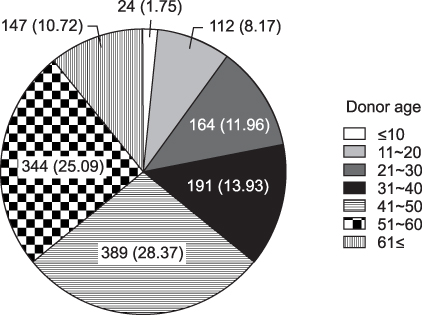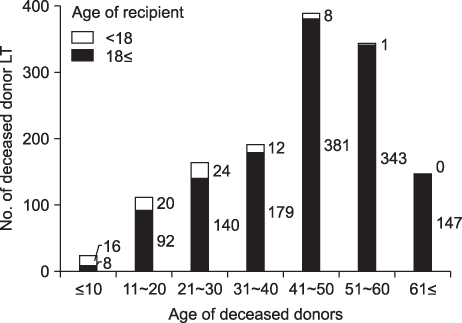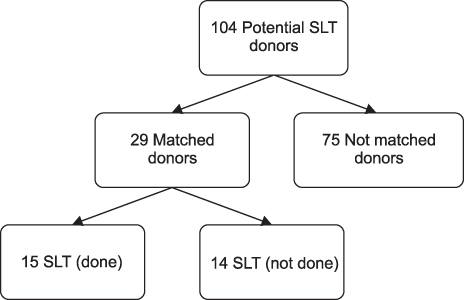Status and Current Problems in the Allocation System for Pediatric Liver Transplantation in Korea
- Affiliations
-
- 1Department of Surgery, Seoul National University College of Medicine, Seoul, Korea. kwleegs@gmail.com
- KMID: 2003535
- DOI: http://doi.org/10.4285/jkstn.2012.26.3.196
Abstract
- BACKGROUND
The aim of this study was to investigate the current status and identify any existing problems in the allocation system of liver transplantation (LT) for children in Korea.
METHODS
The information for the period between January 2006 and March 2012 contained in the Korean Network for Organ Sharing (KONOS) database, and the 2008 and 2010 annual reports from KONOS were analyzed. Detailed information about split LT (SLT) was analyzed using the SLT database which contains data collected since 2010.
RESULTS
Of 4,462 cases of LT between January 2006 and December 2010, 243 were pediatric cases (5.4%). Of these pediatric cases, 195 (80.2%) were living donor LT. Of the liver grafts from deceased pediatric donors, 68% were donated to adults and 3.9% were shared with children. Of the 104 splittable donors from January 2010 to March 2012, a split was performed only in 4.6% of cases. The main reason for the low split rate was few pediatric candidate(s) in the waiting list due to strict Korean regulatory requirements for split candidate registration.
CONCLUSIONS
Under the current liver transplant allocation system, Korean children have less chance to receive a liver graft from a deceased donor. With improvement of the allocation system and the rules governing SLT, children in need may have greater opportunity to receive a deceased donor graft without negatively affecting adult recipients.
Keyword
MeSH Terms
Figure
Cited by 3 articles
-
Pediatric liver transplantation in Korea: long-term outcomes and allocations
Sanghoon Lee, Suk-Koo Lee
Korean J Transplant. 2019;33(1):1-5. doi: 10.4285/jkstn.2019.33.1.1.Prognosis of Split Liver Transplantation Compared with Whole Liver Transplantation in Adult Patients: Single-center Results under the Korean MELD Score-based Allocation Policy
Gil-Chun Park, Shin Hwang, Gi-Won Song, Dong-Hwan Jung, Tae-Yong Ha, Chul-Soo Ahn, Deok-Bog Moon, Ki-Hun Kim, Young-In Yoon, Woo-Hyoung Kang, Hwui-Dong Cho, Jin Uk Choi, Minjae Kim, Byeong-Gon Na, Sang Hoon Kim, Sung-Gyu Lee
J Korean Med Sci. 2020;35(37):e304. doi: 10.3346/jkms.2020.35.e304.Pediatric liver transplantation in Korea: long-term outcomes and allocations
Sanghoon Lee, Suk-Koo Lee
J Korean Soc Transplant. 2019;33(1):1-5. doi: 10.4285/jkstn.2019.33.1.1.
Reference
-
1. Pichlmayr R, Ringe B, Gubernatis G, Hauss J, Bunzendahl H. Transplantation of a donor liver to 2 recipients (splitting transplantation): a new method in the further development of segmental liver transplantation. Langenbecks Arch Chir. 1988. 373:127–130.
Article2. Bismuth H, Houssin D. Reduced-sized orthotopic liver graft in hepatic transplantation in children. Surgery. 1984. 95:367–370.3. Rogiers X, Malago M, Habib N, Knoefel WT, Pothmann W, Burdelski M, et al. In situ splitting of the liver in the heart-beating cadaveric organ donor for transplantation in two recipients. Transplantation. 1995. 59:1081–1083.
Article4. Goss JA, Yersiz H, Shackleton CR, Seu P, Smith CV, Markowitz JS, et al. In situ splitting of the cadaveric liver for transplantation. Transplantation. 1997. 64:871–877.
Article5. Suh KS, Lee KW, Koh YT, Roh HR, Chung JK, Minn KW, et al. First successful in situ split-liver transplantation in Korea. Transplant Proc. 2000. 32:2140.
Article6. Korean Network for Organ Sharing (KONOS). 2008 Annual Report [Internet]. 2009. cited 2012 Apr 10. Seoul: KONOS;Available from: http://konos.go.kr.7. Korean Network for Organ Sharing (KONOS). 2010 Annual Report [Internet]. 2011. cited 2012 Apr 10. Seoul: KONOS;Available from: http://konos.go.kr.8. Korean Network for Organ Sharing (KONOS). Regulations and guidelines for organ transplantation [Internet]. 2011. cited 2012 May 3. Seoul: KONOS;Available from: http://konos.go.kr.9. United Nework for Organ Sharing (UNOS). Organ Distribution: Allocation of Livers [Internet]. 2011. cited 2012 Apr 10. Richmond, VI: UNOS;Available from: http://optn.transplant.hrsa.gov.10. Lee KW, Cameron AM, Maley WR, Segev DL, Montgomery RA. Factors affecting graft survival after adult/child split-liver transplantation: analysis of the UNOS/OPTN data base. Am J Transplant. 2008. 8:1186–1196.
Article11. Busuttil RW, Goss JA. Split liver transplantation. Ann Surg. 1999. 229:313–321.
Article12. Ghobrial RM, Yersiz H, Farmer DG, Amersi F, Goss J, Chen P, et al. Predictors of survival after in vivo split liver transplantation: analysis of 110 consecutive patients. Ann Surg. 2000. 232:312–323.13. Washburn K, Halff G, Mieles L, Goldstein R, Goss JA. Split-liver transplantation: results of statewide usage of the right trisegmental graft. Am J Transplant. 2005. 5:1652–1659.
Article14. Suh KS, Lee HW, Shin WY, Cho EH, Yi NJ, Lee KU. Split liver transplantation. J Korean Soc Transplant. 2007. 21:135–139.
- Full Text Links
- Actions
-
Cited
- CITED
-
- Close
- Share
- Similar articles
-
- Pediatric liver transplantation in Korea: long-term outcomes and allocations
- Status and Current Problems in the Allocation System for Pediatric Liver Transplantation in Korea
- Current Status of Deceased Donor Liver Transplantation for Alcoholic Liver Disease in Korea in MELD Era
- Current Status of Pediatric Liver Transplantation
- Impact of allocation priority for children awaiting liver transplantation: a pediatric liver allocation simulated model analysis




